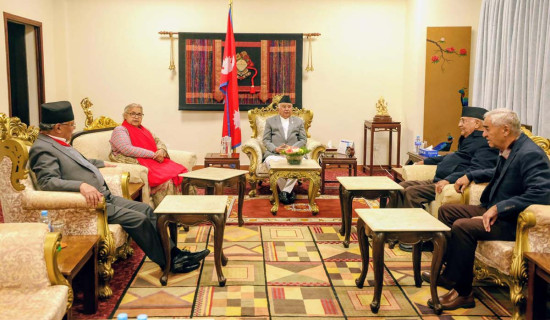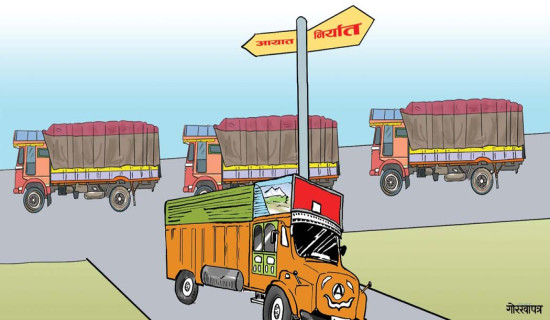- Tuesday, 23 December 2025
Prepare For Rain-induced Disasters
Nepal is one of the most disaster-prone nations in South Asia, with the country recording numerous catastrophes, including rain-induced ones, each year. These disasters cause significant loss to properties and human lives. A fragile geology coupled with erratic monsoon rains, messy urbanisation, imprudent opening of tracks and excavation of river-based products like sands, gravels and stones are some of the key factors leading to such mishaps. The communities living in and around vulnerable areas still do not seem to have been fully aware of potential disasters like flash floods, landslides and inundations they might experience. Despite this challenging situation, the responsible authorities have hardly been found better prepared for preventing and tackling disasters.
As the Department of Hydrology and Meteorology (DHM) has already predicted above-average rains in the upcoming monsoon, the relevant authorities must expedite necessary preparations for dealing with natural calamities. With drastic changes in rain patterns, the country experiences incessant downpours, resulting in devastating floods and landslides, even during periods of pre-monsoon and post-monsoon.
Pre-monsoon flood
Last week, an unexpected incident happened in the Panauti Municipality of Kavrepalanchowk district. A woman was swept away by a flooded rivulet that flows through an area near Subba Gaun of the same municipality. The rivulet was swollen immediately after the area recorded a heavy rainfall for some hours. The 33-year-old woman became the victim of pre-monsoon flood when she was returning home from her farm. Although rescue teams worked hard to search and rescue her, they were unable to recover her body. The incessant rains also caused the Roshi River to swell. The river caused damage to the diversion at Mapti, disrupting the vehicular movement on the BP Highway for hours. Many foreign tourists, as well as domestic passengers travelling to and from Manthali and other places, had to be stranded on the way for several hours. However, the highway resumed its operation, thanks to concerted efforts of different government bodies, including local administration and security agencies.
In late September last year as well, the Roshi River devastated the BP Highway and settlements along its banks. As many as one dozen people lost their lives to the disaster, while many others were wounded. The floods and landslides in the area led to the displacement of about 500 households. The area saw its vital infrastructures, such as a motorable bridge over the Roshi River, an industrial village, and an under-construction hospital, among others, damaged due to floods and landslides. The disasters also eroded a lot of paddy fields, pushing many locals into poverty.
The unceasing rainfall recorded from September 26 to 28 last year proved to be very destructive as it caused extensive flooding and landslides nationwide. The disasters killed more than 220 people and ravaged more than 1,200 private houses. The Kathmandu Valley alone recorded well over three dozen deaths. It is appalling that four people had to lose their lives after being swept away by the Nakhhu Khola. Although they were calling for help from the roof of a shed, no rescue team was able to help them.
The responsible authorities were criticised for their utter failure to rescue those in a critical situation even within the Kathmandu Valley. That unfortunate incident was a clear indication that the rescue teams were not equipped enough to save the lives of those in difficulty. Several people went missing while many others got injured. The rain-induced calamities also damaged numerous roads and other physical infrastructures. Kavrepalanchok, Kathmandu, Lalitpur, Dhading and Sindhuli were among the highly disaster-hit districts.
What was equally ironic was that around three dozen people had to lose their lives at Jhyaplekhola of Dhading district because of the local authorities’ inability to stop vehicular movement along highways. Making the authorities alert against possible disasters on highways, the DHM had asked them not to allow night buses to operate. But they did not take the matter seriously. The negligence on their part shows their utter insensitivity. Had those authorities carried out their responsibility sensibly, that tragedy would have been prevented.
In Nepal, disaster risk management plans are in place. What is lacking is their effective enforcement. The authorities must pay much attention to prevention and mitigation. The government has installed early warning systems at different locations to inform communities about possible disasters such as floods and landslides. However, it has to install these systems in more areas. Though developing disaster-resilient infrastructures is a costly affair, the government appears to have adopted the policy of going for such infrastructures, especially in areas susceptible to water-induced calamities.
Crucial role
Learning from past mistakes, the National Disaster Risk Reduction and Management Authority (NDRRMA) and other agencies involved in disaster management must focus their efforts on disaster preparedness in view of the coming monsoon. Without making timely preparations, it is not possible to manage disasters in a desirable way. It is necessary to train security personnel and other employees to be mobilised for search, rescue and rehabilitation so as to enable them to perform their responsibilities in a successful manner.
Collaborative and coordinating endeavours alone can be effective in preventing and minimising the impacts of natural disasters. The local governments have a more crucial role to play in this connection as they are very close to the people. Educating people about disaster risks, weather-related information and preventive measures is essential for preparedness. As disaster preparedness is a comprehensive task, much focus must be laid on it to prevent water-induced and other calamities.
(The author is a former deputy executive editor of this daily.)
















